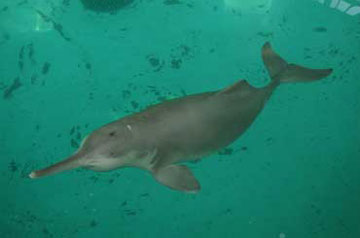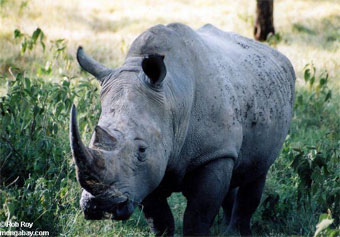Saving beautiful – and ugly – species from extinction
Saving the beautiful – and the ugly – creatures of the world
Why the EDGE Matters
Jeremy Hance
August 30, 2007
|
|
Allow me to wax poetic about the world’s newest wildlife organization, EDGE. I must admit I’m a little in love. This singular organization was founded in January as a part of the London Zoological Society. Its basic tenants remain similar to other endangered species programs: survey populations, set up conservation programs, work with local governments and communities to ensure protection. However, what is unique about EDGE is not their approach to saving species, but rather the species they choose to focus their efforts on. This year they have selected ten mammalian species: the Yangztee River Dolphin, Attenborough’s Long-Beaked Echidna, Hispaniolan Solenodon, Bactarian Camel, Pygmy Hippopotamus, Slender Loris, Hirola, Golden-rumped Elephant Shrew, Bumblebee Bat, and the Long-eared Jerboa. Now, how many of those have you heard of? How many can you picture? Unless you are a biologist or a one-of-a-kind wildlife enthusiast, you may recognize a couple (or less) of these species—and that’s the point. By selecting relatively unheard-of species, EDGE looks to the future of conversation movements while reconnecting us to religious and moral beliefs regarding the immeasurable importance of all of our planet’s inhabitants.

The Baiji or Yangtze River Dolphin. Photo by Wang Ding and courtesy of the Institute of Hydrobiology, Chinese Academy of Sciences. |
Conservation organizations of the past have chosen to protect species on what is often called ‘charisma’, selecting animals that easily attract us (when I say easily, I mean the animal is striking enough not to need much ‘explanation’ to make it interesting). Whales are massive and awe-inspiring, tigers are beautiful and deadly, polar bears are elegant and seemingly ‘cute’, elephants are grand and intelligent, lions retain the myth of kingship, dolphins are clever and sleek, wolves have come to symbolize wildness, and chimpanzees are obviously so close to ourselves that their protection is in some ways self-protection. A few ‘rules’ can be deemed from the above list of favorite conservation animals. First, to have a wildlife organization’s focus, it is best to be mammal; since we are mammals it is only natural that we gravitate toward our relatives (birds are the next best, like the Bald Eagle and California Condor, but reptiles, amphibians, fish, and—least of all—insects and plants are rarely made the subject of species-focused conservation efforts). Secondly, it helps to be big, in fact the bigger the better; animals smaller than ourselves are rarely noticed unless they are labeled ‘cute’. Third, the species should be active and energetic; we don’t care as much for animals that seem to do little. Finally, symbolism or metaphors that may surround an animal also aid its stature. In general, we prefer predators to prey, intelligence to instinct, and beauty to ugly. The core reason for focusing on such species is obvious: people donate far more to save a Panda Bear than a Tumbala Climbing-Rat (one of EDGE’s choice species).
Now cynicism could easily set in after one realizes we are saving animals based on looks. But conservation organizations put their faith in a trickle-down theory; in other words saving the big charismatic mammals would theoretically benefit every species in their ecosystem: by conserving elephants and lions you conserve the all the species of the Africa’s plains or by saving whales and dolphins you protect the seas. I will label this as trickle-down conservation, and much like Reagan’s dubious economics it is only a little effective. For one thing, nature is endlessly diverse and their are many habitats that have been ignored due to the lack of any charismatic animal; for example the Hispaniolan Solenodon, an amazing shrew-like creature that produces toxic saliva, lives in Haiti (well, hopefully) and the Domican Republic, two nations that have received relatively little international conservation attention, because of their lack of any high-profile animal. There are many such places. However, even massive protection for one species doesn’t necessarily mean benefits for the others. Kenya is one of the countries in which international organizations have sunk a lot of money to protect lions, elephants, and many other big mammalian species. Yet such protection has not stopped the Hirola from becoming one of the most endangered mammals in the world, simply because it inhabits a region apart from the African savannah, while even the Black Rhinoceros—which inhabits the same area as Africa’s big charismatic starts—remains on the very edge of extinction. Why? Because not every animal requires the same protection; every endangered species needs specifics plans to address its very specific needs. The Black Rhinoceros is hunted even more vigorously for its horn than the elephant for its tusk, and its aggressive nature has not helped it win the same devotion. Finally saving mammals and a few majestic birds does little to help other orders of life. Saving Jaguars does not translate into stopping the devastating losses in frog populations even if both animals inhabit the Amazon. Protecting whales does not mean any greater support for sharks, fish, or coral. Like trickle-down economics, trickle-down conservation mostly just helps the higher class species.
 The Long-beaked echidna (Zaglossus bruijni), a species closely related to Attenborough’s long-beaked echidna (Zaglossus attenboroughi), from the Foja mountains in New Guinea. Photo by Stephen Richards of Conservation International. |
With one swoop, EDGE has changed the trickle-down, beauty-is-best conservation idea. They have set up new criteria: any animals will receive attention so long as they are greatly endangered and ‘evolutionary distinct’. That last part may raise a few brows, but basically it states that animal conservation should not be a charismatic contest, but rather emphasis should be placed first on those animals that are biologically unique. The idea is that the more unique the species, the greater the loss. With a possible mass extinction to rival the dinosaurs’ on the horizon and only a finite amount of resources and time, emphasis must be placed somewhere. While such criteria may sound as constrictive as beauty-is-best, it is not. The animals are selected objectively, through a score combining endangerment and evolutionary distinctness. The result: seventy mammals with little or no conservation have been added to the small list of species that should not be allowed to enter the long dark of extinction without a fight. None of this is meant to diminish the need to save such magnificent animals as the Blue Whale and the African Elephant—both of which also appear in EDGE’s 100 mammals list. These beautiful charismatic animals still deserve the very best in conservation efforts, and without past dedication many of them would be gone.
EDGE is not merely concerned with mammals. The organization is currently working on lists of the most endangered and most unique amphibians, birds, reptiles, and even plants. Once these lists are developed, the selected species will receive the same attention as their mammalian cousins. I hope once more resources become available EDGE will compile similar lists for insects and fish. Imagine the impact of such a broad-reaching organization—so long as it receives the necessary public support and funding.
 Black rhino in Kenya. Photo by Rob Roy (top). |
In this incredible expansion of species worth saving—including fruit bats, burrowing toads, and palm trees—EDGE is not necessarily achieving something new so much as it is looking back on pre-Industrial Age views of the natural world’s importance. The idea that animals should not be rated according to their usefulness, charisma, or beauty is as old as religion, in fact the reverence for nature may have inspired the first religious cultures. Even now, most philosophical and religious traditions press for the equality of life. Buddhism teaches non-violence toward every living thing, from man to the dung beetle. Hinduism as well teaches great respect for the natural world and all its inhabitants. In the philosophies and religions of Native Americans, Aboriginals, Amazonians, and tribal Africans animals are portrayed as brethren to be treated with respect and reverence. There is no talk in these cultures of eradication of a species; all are seen as necessary to the whole. And all of the Abrahamic religions (Christianity, Islam, and Judaism) contain the story of Noah’s Ark in which God orders Noah to save every species from the flood. Never do Noah and God have a discussion whether the weevil is worth more than a lion. There is no ‘deserves’ in these multitude of philosophies and traditions; all life is sacred. All life should be protected and cherished. EDGE reaches closer to this moral ideal than previous institutions. Certainly, they must still decide to focus on particular species—they are bound by finite finances and support—but its system of selection is far closer to these moral traditions than beauty and cuteness contests.
Incredibly, the organization has already achieved a magnificent success: evidence that Attenborough’s Long-beaked Echidna still exists in the foothills of Indonesia. Last year this animal was among the ‘probably extinct’—certainly the rarest-of-the-rare—since it was only known from a single specimen collected 46 years ago. Now, thanks to EDGE we know that this unique species is still alive, roaming the Cyclops Mountains. Rediscovering an ‘extinct’ species: not bad for six months. As well, this young organization has achieved something quite remarkable: media attention. Several articles have appeared on BBC, Slate.com (an online magazine) had an article and photo slideshow, and the July issue of National Geographic also contained an article. All of these articles incorporate photos and information not of whales, tigers, and elephants, but of Aye-Ayes, Slow Loris, and the Pygmy Hippopotamus. Suddenly, the world is seeing other animals on the brink, and who says a child can’t be as fascinated by a Bumblebee Bat as a Panda Bear (I mean it’s literally a bat the size of a bee!).
As I conclude, allow me to state that none of this is meant to diminish the incredible work that other conservation organizations are doing and have done for the past 100 years—without them much would be irrevocably and pathetically lost. These courageous people have saved us that shame. Yet EDGE is just one harbinger of how such organizations are changing and shifting. With new strategies, new awareness, new technologies, and most importantly a major shift in values and philosophies, we can still sustain our planet’s most unique attribute: life. Just this week BirdLife International has declared a bold new program to establish conservation programs for 189 of the world’s Critically Endangered birds. This new initiative just proves the incredible change occurring in conservation organizations. We are realizing it is not enough to save just the tigers, elephants, and whales; it is not enough to have a piecemeal environment. Such a place would be a decayed menagerie with ourselves as its apathetic masters. No, allow us to be bold. Allow us to be optimistic. Instead of saving just a part of our planet—bits here and there—allow us to press ahead and preserve the whole wondrous thing, from Golden-rumped Elephant-Shrews to Long-eared Jerboas, from Bumblebee Bats to Long-beaked Echidnas.
About Jeremy Leon Hance
Since graduating in 2002 from Macalester College, Jeremy has been fortunate enough to travel to three continents, live a year in New York City, manage a co-op in a small town on the wind-swept Minnesota prairie, and spend a precious morning watching a family of Giant River Otters fish and play in the Amazon basin. Jeremy previously wrote about the media’s response to the extinction of the baiji.